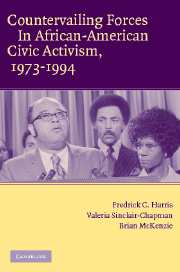Book contents
- Frontmatter
- Contents
- List of Figures and Tables
- Acknowledgments
- 1 Introduction
- 2 Good Times and Bad: Trends in the Economic, Social, and Political Conditions of African Americans in the Post–Civil Rights Era
- 3 Studying Group Activism: Toward a Macro Approach to Black Civic Participation
- 4 Echoes of Black Civic Activism: Historical Foundations and Longitudinal Considerations
- 5 Shifting Forces: Modeling Changes in Post–Civil Rights Black Activism
- 6 From Margin to Center: Bringing Structural Forces into Focus in the Analysis of Black Activism
- Appendix A Question Wording and Coding
- Appendix B Variable Sources and Descriptions
- Appendix C Time Series Models
- References
- Index
3 - Studying Group Activism: Toward a Macro Approach to Black Civic Participation
Published online by Cambridge University Press: 15 December 2009
- Frontmatter
- Contents
- List of Figures and Tables
- Acknowledgments
- 1 Introduction
- 2 Good Times and Bad: Trends in the Economic, Social, and Political Conditions of African Americans in the Post–Civil Rights Era
- 3 Studying Group Activism: Toward a Macro Approach to Black Civic Participation
- 4 Echoes of Black Civic Activism: Historical Foundations and Longitudinal Considerations
- 5 Shifting Forces: Modeling Changes in Post–Civil Rights Black Activism
- 6 From Margin to Center: Bringing Structural Forces into Focus in the Analysis of Black Activism
- Appendix A Question Wording and Coding
- Appendix B Variable Sources and Descriptions
- Appendix C Time Series Models
- References
- Index
Summary
I am because we are.
African proverbWe have now surveyed the economic, social, and political forces that characterize the political progress and the social and economic setbacks of African Americans in the post–civil rights era. Our theory of countervailing forces argues that political empowerment and social and economic distress have competing effects on black civic participation. In exploring the opposing forces of empowerment and distress, we take a macro approach to analyzing black civic and political participation. Rather than examining black civic participation as an artifact of individual behavior, we examine black participation in aggregates, which allows us to present a more analytically consistent profile of black civic activism than previous studies.
Consider the two fictional families we profiled in Chapter 1, the Jeffersons and the Evans. Each member from both families has different levels of participation. Louise Jefferson participates more than her husband George, but Louise and Florida Evans might participate at the same level, and both women might participate less than Florida's son, Michael. Even though George Jefferson's participation is lower than his wife's, it might be higher than James Evans' participation levels, whose participation might be lower than his daughter Thelma's, but only slightly lower than his son, J.J.'s. The participation of the Jefferson's son Lionel might be less than that of his parents, and all the members of the Evans family.
- Type
- Chapter
- Information
- Publisher: Cambridge University PressPrint publication year: 2005



